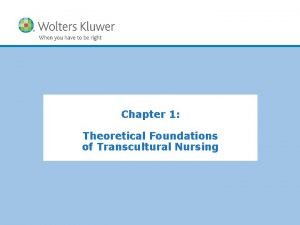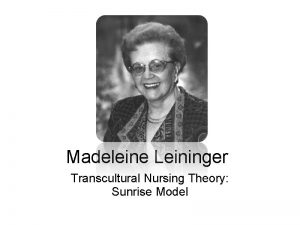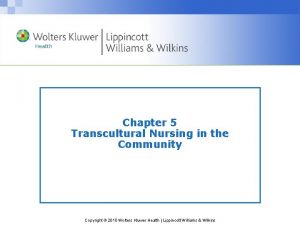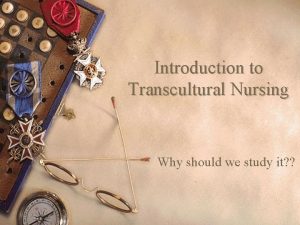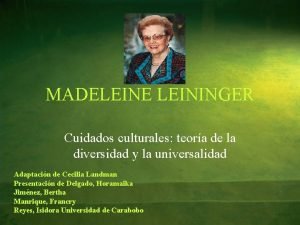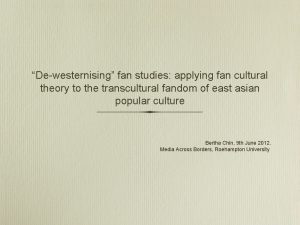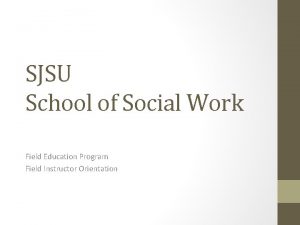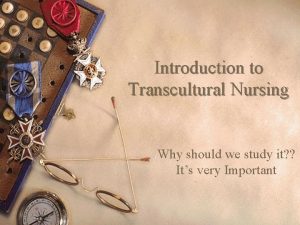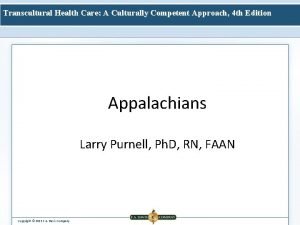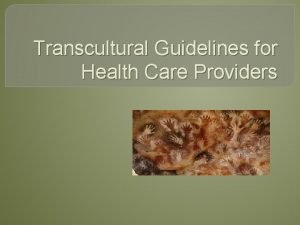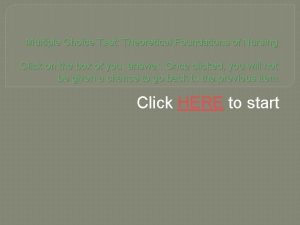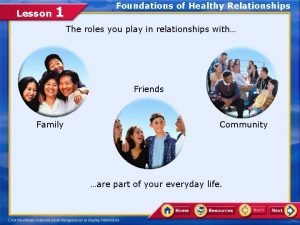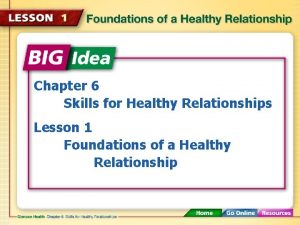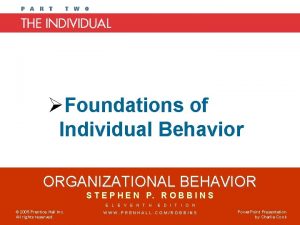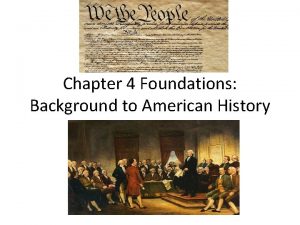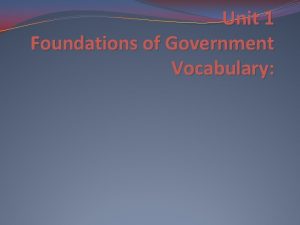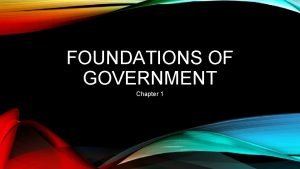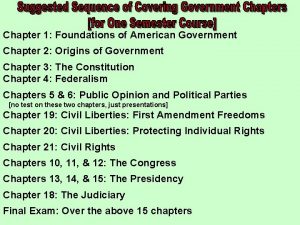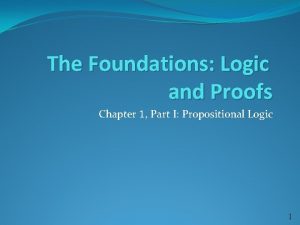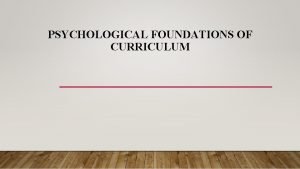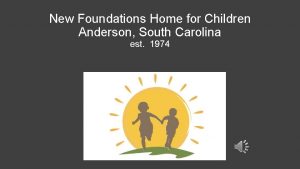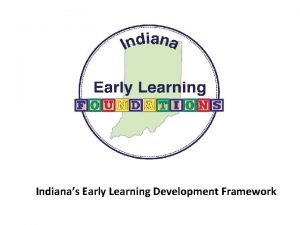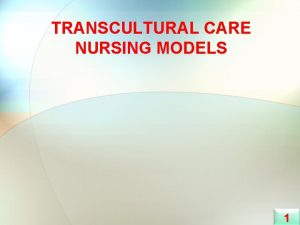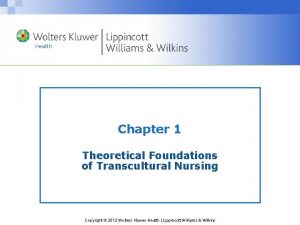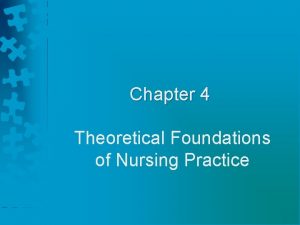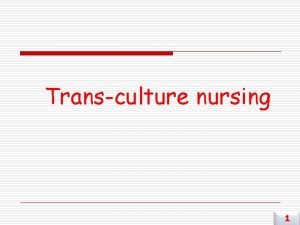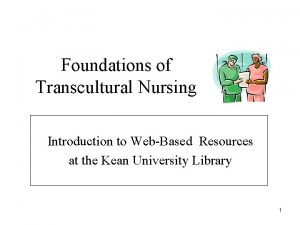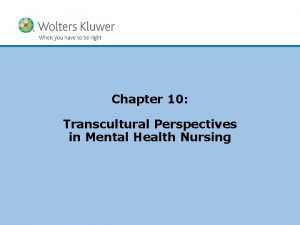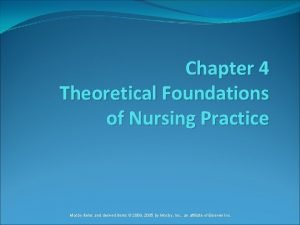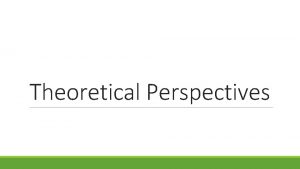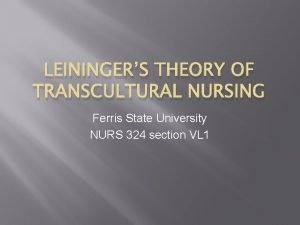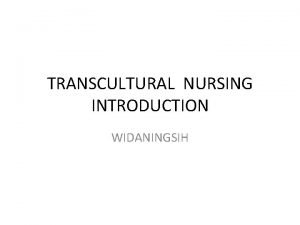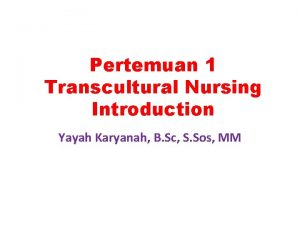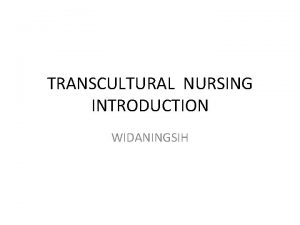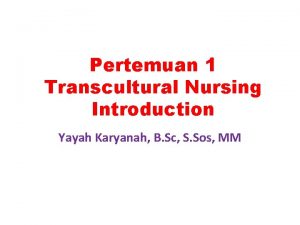Chapter 1 Theoretical Foundations of Transcultural Nursing Copyright































- Slides: 31

Chapter 1: Theoretical Foundations of Transcultural Nursing Copyright © 2016 Wolters Kluwer Health | Lippincott Williams & Wilkins

Transcultural Nursing • The blending of nursing and anthropology into an area of specialization within the discipline of nursing • Conceptualized by Dr. Leininger • A formal area of study that uses the concepts of culture and caring Copyright © 2016 Wolters Kluwer • All Rights Reserved

Transcultural Nursing (cont. ) • Transcultural nursing (TCN) is a nursing specialty focused on the comparative study and analysis of cultures and subcultures. • It examines these groups with respect to their: – Caring behavior – Nursing care – Health–illness values and beliefs – Patterns of behavior Copyright © 2016 Wolters Kluwer • All Rights Reserved

Transcultural Nursing (cont. ) • Transcultural nursing’s goal is to: – Develop a scientific and humanistic body of knowledge in order to provide nursing care that is both • Culture specific • Culture universal Copyright © 2016 Wolters Kluwer • All Rights Reserved

Transcultural Nursing (cont. ) • Culture-specific refers to: – Particular values, beliefs, and patterns of behavior that tend to be special or unique to a group and do not tend to be shared with members of other cultures • Culture-universal refers to: – The commonly shared values, norms of behavior, and life patterns that are similarly held among cultures about human behavior and lifestyles Copyright © 2016 Wolters Kluwer • All Rights Reserved

Question • Is the following statement true or false? • Methods, rules, guidelines, and patterns of behavior about food practices can be described as culture-specific. Copyright © 2016 Wolters Kluwer • All Rights Reserved

Answer • True • Rationale: The need for food is a culture-universal. • Culture-specific determines methods, rules, guidelines, and patterns of behavior. For example, items that are considered to be edible; acceptable methods used to prepare and eat meals; rules concerning who eats with whom, the frequency of meals, etc. Copyright © 2016 Wolters Kluwer • All Rights Reserved

Transcultural Nursing (cont. ) Anthropology: • The study of humans including their: – Origins – Behavior – Social relationships – Physical and mental characteristics – Customs – Development through time and in all places in the world Copyright © 2016 Wolters Kluwer • All Rights Reserved

Transcultural Nursing (cont. ) • Culture (as defined by Leininger) the “learned, shared, and transmitted values, beliefs, norms, and lifeways of a particular group of people that guide thinking, decisions, and actions in a patterned way… Culture is the blueprint that provides the broadest and most comprehensive means to know, explain, and predict people’s lifeways over time and in different geographic locations. ” Copyright © 2016 Wolters Kluwer • All Rights Reserved

Transcultural Nursing (cont. ) • Influences a person’s definition of health and illness • Oftentimes connotes a person’s racial or ethnic background. Culture also encompasses: – Socioeconomic status – Ability or disability – Sexual orientation – Age – Occupation or profession Copyright © 2016 Wolters Kluwer • All Rights Reserved

Transcultural Nursing (cont. ) • Ethnicity – The perception of oneself and a sense of belonging to a particular ethnic group or groups. It can also mean feeling that one does not belong to any group because of multiethnicity. • Currently five classifications; however, some people may identify with more than one ethnicity/race. Copyright © 2016 Wolters Kluwer • All Rights Reserved

Transcultural Nursing (cont. ) • Race – Refers to a group of people who share such genetically transmitted traits as skin color, hair texture, and eye shape or color. • Races are arbitrary classifications that lack definitional clarity; all cultures have their own ways of categorizing or classifying their members. Copyright © 2016 Wolters Kluwer • All Rights Reserved

Historical and Theoretical Foundations of Transcultural Nursing • Transcultural nursing: – Dr. Madeleine M. Leininger, nurse anthropologist – Initial conception in the 1950 s – Formal creation as a specialty and new discipline within the profession in the 1960 s− 1970 s – Nurse scholars have generated a substantial and important body of theoretical, research, and evidencebased knowledge in TCN, which is ongoing. Copyright © 2016 Wolters Kluwer • All Rights Reserved

Question • Is the following statement true or false? • Transcultural nursing has been formally considered a nursing specialty since 2000. Copyright © 2016 Wolters Kluwer • All Rights Reserved

Answer • False • Rationale: Transcultural nursing was formally considered as a specialty and new discipline within the profession in the 1960 s and 1970 s. Copyright © 2016 Wolters Kluwer • All Rights Reserved

Leininger’s Contribution to Transcultural Nursing Theory of Culture Care Diversity and Universality • Focuses on describing, explaining, and predicting nursing similarities and differences focused primarily on human care and caring in human cultures Sunrise Enabler • Visual representation of the concepts of her theory. Based on the concept of cultural care that guides nursing judgments and activities to provide culturally congruent care Copyright © 2016 Wolters Kluwer • All Rights Reserved

Leininger’s Sunrise Enabler Copyright © 2016 Wolters Kluwer • All Rights Reserved

Leininger’s Contribution to Transcultural Nursing (cont. ) • Established the Transcultural Nursing Society (TCNS) • TCNS Newsletter • Created the Journal of Transcultural Nursing (JTN) and served as founding editor • Established the first master’s and doctoral programs in nursing with a theoretical and research focus in TCN • Created a new qualitative research method called enthnonursing research to investigate phenomena of interest in TCN Copyright © 2016 Wolters Kluwer • All Rights Reserved

Question • Is the following statement true or false? • Dr. Madeleine M. Leininger authored both conceptual frameworks, the Theory of Culture Care Diversity and Universality and the Sunrise Model. Copyright © 2016 Wolters Kluwer • All Rights Reserved

Answer • True • Rationale: Dr. Madeleine M. Leininger is credited with authoring both of these conceptual frameworks related to transcultural nursing. Copyright © 2016 Wolters Kluwer • All Rights Reserved

Advancements in Transcultural Nursing • Expanded models by nursing scholars: – Giger and Davidhizar Transcultural Assessment Model – Purnell Model for Cultural Competence – Campinha-Bacote Model of Cultural Competence in the Delivery of Healthcare Services Copyright © 2016 Wolters Kluwer • All Rights Reserved

Advancements in Transcultural Nursing (cont. ) • The Core Curriculum has been established to support TCN practice with a core base of knowledge. • Used in a variety of practice settings. • Two certifications offered in TCN, basic and advanced. Copyright © 2016 Wolters Kluwer • All Rights Reserved

Andrews/Boyle Transcultural Interprofessional Practice (TIP) Model • A new model, uses the scientific process for delivering culturally congruent, quality care to people from diverse backgrounds across the life span • Facilitates the delivery of nursing and health care consistent with cultural beliefs and practices of clients from diverse backgrounds • Provides a conceptual framework to guide nurses in the delivery of culturally congruent care that is theoretically sound Copyright © 2016 Wolters Kluwer • All Rights Reserved

TIP Model (cont. ) • Components of the model; the context from which people's health-related values, attitudes, beliefs, and practices emerge: – Interprofessional Health Care Team – Communication – Problem Solving Copyright © 2016 Wolters Kluwer • All Rights Reserved

TIP Model (cont. ) ● Interprofessional Health Care Team - Client at its core - May also include: Family and support persons, other healthcare personnel, traditional, folk and religious healers - All providers working together to deliver the highest quality of care - A partnership among client and providers that establishes trust, collaboration, cooperation, and communication Copyright © 2016 Wolters Kluwer • All Rights Reserved

TIP Model (cont. ) • Communication – Verbal—spoken word, language (over 6, 000 worldwide), tone of voice, abbreviations, idioms – Nonverbal—how people convey meaning without words. Facial expressions, gestures, posture, physical distance, silence, eye contact – Mixed—modesty, technology assisted Copyright © 2016 Wolters Kluwer • All Rights Reserved

TIP Model (cont. ) • Problem solving – Guides health care teams in determining what the client needs to obtain optimal well-being and health. • Comprehensive assessment skills • Mutual goal setting • Planning care • Implementing care • Evaluation of care to achieve the goals of: • Culturally congruent, competent, quality care based on evidence and best practice Copyright © 2016 Wolters Kluwer • All Rights Reserved

TIP Model (cont. ) Copyright © 2016 Wolters Kluwer • All Rights Reserved

TIP Model (cont. ) • Proficiency in using the problem-solving process requires time and repeated simulated and/or clinical experiences. • Developing competence is uneven and nonlinear, as is the process of developing cultural competence. Copyright © 2016 Wolters Kluwer • All Rights Reserved

Question • Which of the following is an example of verbal communication? A. Avoiding eye contact B. Nodding to convey understanding C. Speaking another language D. Arms folded and legs crossed Copyright © 2016 Wolters Kluwer • All Rights Reserved

Answer • C. Speaking another language • Rationale: Speaking another language is a verbal communication method. This is an example of the spoken word versus nonverbal communication, which is conveying meaning without words. Copyright © 2016 Wolters Kluwer • All Rights Reserved
 Sunrise enabler
Sunrise enabler Leininger's sunrise model
Leininger's sunrise model Transcultural nursing questions
Transcultural nursing questions Definition of transcultural nursing
Definition of transcultural nursing Teoria de madeleine leininger
Teoria de madeleine leininger Fan culture theory
Fan culture theory Sjsu msw
Sjsu msw Culturally congruent care definition
Culturally congruent care definition Transcultural health care definition
Transcultural health care definition Transcultural health care definition
Transcultural health care definition Theoretical foundation in nursing quiz
Theoretical foundation in nursing quiz What are the three c's of healthy relationships
What are the three c's of healthy relationships Chapter 6 lesson 1 foundations of a healthy relationship
Chapter 6 lesson 1 foundations of a healthy relationship Describe the care team and the chain of command
Describe the care team and the chain of command Foundations of individual behaviour
Foundations of individual behaviour Foundations of government guided reading activity section 1
Foundations of government guided reading activity section 1 Chapter 4 foundations background to american history
Chapter 4 foundations background to american history Foundations in personal finance answers chapter 1
Foundations in personal finance answers chapter 1 Foundations of government vocabulary
Foundations of government vocabulary Chapter 1: foundations of government pdf
Chapter 1: foundations of government pdf Foundations of government (chapter 1 test form a)
Foundations of government (chapter 1 test form a) Functional nursing
Functional nursing Nursing care plan of ocd
Nursing care plan of ocd Nursing diagnosis of cataract
Nursing diagnosis of cataract Conclusion of nursing process
Conclusion of nursing process Nursing process in psychiatric nursing
Nursing process in psychiatric nursing The foundations logic and proofs
The foundations logic and proofs California preschool curriculum framework
California preschool curriculum framework What are the five psychological foundations of curriculum
What are the five psychological foundations of curriculum New foundations home for children
New foundations home for children Indiana early learning foundations
Indiana early learning foundations
